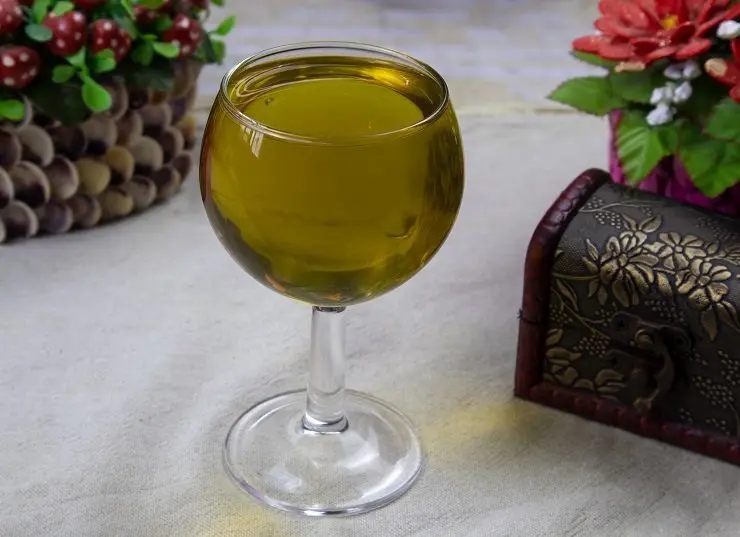Basil wine is remembered for its rich fragrant aroma with mint notes on the palate and light citrus hues. Drink for an amateur, but has its fans.
Green (fragrant) or purple basil (reihan) is suitable for cooking. The difference will be only in the color of the wine (emerald or light red), the taste and aroma are identical in both cases. The leaves should be fresh and fragrant, the stems and other parts of the plant are not used, as they spoil the taste – bitterness and herbal notes appear.
To prevent contamination of wine with pathogenic microorganisms, fermentation and aging containers, as well as all tools, must be sterilized with boiling water, then wiped dry with a clean cloth.
Ingredients:
- water – 2 liters;
- fresh basil leaves (green or purple) – 250 grams;
- sugar – 400 grams plus to taste for sweetening;
- lemons – 2 pieces;
- wine yeast (or sourdough) – per 2,5 liters of must.
Lemon zest enriches the aroma of wine, and lemon juice regulates acidity, which positively affects the fermentation and taste of the drink. Instead of wine yeast, you can take homemade raisin sourdough (prepared 3-5 days before working with raw materials).
basil wine recipe
1. Bring the water to a boil, add 200 grams of sugar (50%), stir until the sugar is completely dissolved.
2. Put the washed basil leaves into an enamel pan, pour over the hot sugar syrup prepared in the previous step. Cover with a lid and leave for 2 hours.
3. Wash the lemons in warm running water, then wipe dry to remove the preservative used to treat the fruits from the surface. Gently remove the zest from the lemons with a knife or vegetable peeler – the yellow part of the peel without white pulp (very bitter).
4. Add the zest to the basil must, squeeze the lemon juice from two fruits into the same place. Add wine yeast or sourdough.
Attention! The temperature of the wort must be below 30°C, otherwise the yeast may die.
5. Transfer the pan to a dark place at room temperature, tie the neck with gauze to protect against insects. Leave for 3 days. Once every 8-12 hours, stir with a clean hand or a wooden stick, drowning the pulp in the liquid – the floating basil leaves.
After 2-10 hours after the introduction of yeast (sourdough), signs of fermentation should appear: foam, hiss and a slight sour smell.
6. Strain the wort through cheesecloth, squeeze the leaves well (no longer needed).
7. Add 100 grams of sugar (25%) to the liquid part. Mix.
8. Pour the wort into a fermentation tank (fill up to a maximum of 75% of the volume to leave room for another portion of sugar, foam and carbon dioxide). Install a water seal of any design on the neck. You can attach a medical glove with a needle pierced hole in one of the fingers.

9. Transfer to a dark place or cover, leave until the end of fermentation at a stable temperature of 18-27 °C.
10. After 5 days, add the remaining sugar – 100 grams (25%). To do this, pour 200 ml of wort through a tube into a separate container, dilute sugar in it, then add the resulting syrup back to the fermentation container and close it with a water seal.
Depending on yeast and temperature, basil wine will ferment for 35-55 days. Signs of the end of fermentation: lack of gas from the water seal (glove deflated), sediment at the bottom, clarification of the wort.
Attention! If the wine has been fermenting for more than 45 days from the date of installation of the water seal, in order to avoid bitterness, it must be drained from the sediment into another container and left to ferment under a water seal at the same temperature.
11. Remove the fermented young wine from the sediment. Add sugar to taste for sweetness. Separately, you can fix basil wine with vodka or alcohol in an amount of 2-15% by volume. Fortified wine keeps better, but tastes a little tougher.
12. Fill the aging tanks with wine to the top so that there is no contact with oxygen. Close hermetically. If sugar was introduced at the previous stage, it is advisable to keep the containers under a water seal for the first 7-10 days in case of repeated fermentation.
13. Transfer the wine to a dark room with a temperature of 2-16 ° C and leave for at least 2-3 months for maturation (preferably 5-7). When a precipitate appears with a layer of 3-5 cm, filter the drink by pouring it through a tube into another container.
14. When the sediment no longer falls for at least a month, the wine is considered ready. It can be bottled for storage and hermetically sealed.
When stored in the refrigerator or cellar, homemade basil wine has a shelf life of 2-3 years. Fortress – 9-12%. The drink is afraid of direct sunlight, under the influence of which it quickly changes color to gray.










